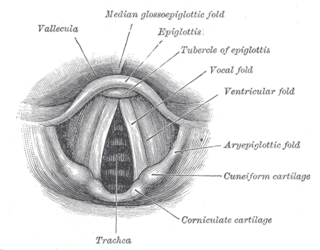
In speech science and phonetics, a formant is the broad spectral maximum that results from an acoustic resonance of the human vocal tract. In acoustics, a formant is usually defined as a broad peak, or local maximum, in the spectrum. For harmonic sounds, with this definition, the formant frequency is sometimes taken as that of the harmonic that is most augmented by a resonance. The difference between these two definitions resides in whether "formants" characterise the production mechanisms of a sound or the produced sound itself. In practice, the frequency of a spectral peak differs slightly from the associated resonance frequency, except when, by luck, harmonics are aligned with the resonance frequency, or when the sound source is mostly non-harmonic, as in whispering and vocal fry.

The human voice consists of sound made by a human being using the vocal tract, including talking, singing, laughing, crying, screaming, shouting, humming or yelling. The human voice frequency is specifically a part of human sound production in which the vocal folds are the primary sound source.

In physics, acoustics, and telecommunications, a harmonic is a sinusoidal wave with a frequency that is a positive integer multiple of the fundamental frequency of a periodic signal. The fundamental frequency is also called the 1st harmonic; the other harmonics are known as higher harmonics. As all harmonics are periodic at the fundamental frequency, the sum of harmonics is also periodic at that frequency. The set of harmonics forms a harmonic series.

An overtone is any resonant frequency above the fundamental frequency of a sound. In other words, overtones are all pitches higher than the lowest pitch within an individual sound; the fundamental is the lowest pitch. While the fundamental is usually heard most prominently, overtones are actually present in any pitch except a true sine wave. The relative volume or amplitude of various overtone partials is one of the key identifying features of timbre, or the individual characteristic of a sound.

Pitch is a perceptual property that allows sounds to be ordered on a frequency-related scale, or more commonly, pitch is the quality that makes it possible to judge sounds as "higher" and "lower" in the sense associated with musical melodies. Pitch is a major auditory attribute of musical tones, along with duration, loudness, and timbre.

Singing sand, also called whistling sand, barking sand, booming sand or singing dune, is sand that produces sound. The sound emission may be caused by wind passing over dunes or by walking on the sand.

A dog whistle is a type of whistle that emits sound in the ultrasonic range, which humans cannot hear but some other animals can, including dogs and domestic cats, and is used in their training. It was invented in 1876 by Francis Galton and is mentioned in his book Inquiries into Human Faculty and Its Development, in which he describes experiments to test the range of frequencies that could be heard by various animals, such as a house cat.

Silence is the absence of ambient audible sound, the emission of sounds of such low intensity that they do not draw attention to themselves, or the state of having ceased to produce sounds; this latter sense can be extended to apply to the cessation or absence of any form of communication, whether through speech or other medium. Remaining mute can be a symptom of mental illness.
A register is the range within pitch space of some music or often musical speech. It may describe a given pitch or pitch class, a human voice or musical instrument, or both, as in a melody or part. It is also often related to timbre and musical form. In musical compositions, it may be fixed or "frozen".
A multiphonic is an extended technique on a monophonic musical instrument in which several notes are produced at once. This includes wind, reed, and brass instruments, as well as the human voice. Multiphonic-like sounds on string instruments, both bowed and hammered, have also been called multiphonics, for lack of better terminology and scarcity of research.
A stop with no audible release, also known as an unreleased stop or an applosive, is a stop consonant with no release burst: no audible indication of the end of its occlusion (hold). In the International Phonetic Alphabet, lack of an audible release is denoted with an upper-right corner diacritic after the consonant letter, as in:, ,.

A vocal register is a range of tones in the human voice produced by a particular vibratory pattern of the vocal folds. These registers include modal voice, vocal fry, falsetto, and the whistle register. Registers originate in laryngeal function. They occur because the vocal folds are capable of producing several different vibratory patterns. Each of these vibratory patterns appears within a particular range of pitches and produces certain characteristic sounds.

Helmholtz resonance, also known as wind throb, refers to the phenomenon of air resonance in a cavity, an effect named after the German physicist Hermann von Helmholtz. This type of resonance occurs when air is forced in and out of a cavity, causing the air inside to vibrate at a specific natural frequency. The principle is widely observable in everyday life, notably when blowing across the top of a bottle, resulting in a resonant tone.

Hearing range describes the frequency range that can be heard by humans or other animals, though it can also refer to the range of levels. The human range is commonly given as 20 to 20,000 Hz, although there is considerable variation between individuals, especially at high frequencies, and a gradual loss of sensitivity to higher frequencies with age is considered normal. Sensitivity also varies with frequency, as shown by equal-loudness contours. Routine investigation for hearing loss usually involves an audiogram which shows threshold levels relative to a normal.
Evolutionary musicology is a subfield of biomusicology that grounds the cognitive mechanisms of music appreciation and music creation in evolutionary theory. It covers vocal communication in other animals, theories of the evolution of human music, and holocultural universals in musical ability and processing.
Sympathetic resonance or sympathetic vibration is a harmonic phenomenon wherein a passive string or vibratory body responds to external vibrations to which it has a harmonic likeness. The classic example is demonstrated with two similarly-tuned tuning forks. When one fork is struck and held near the other, vibrations are induced in the unstruck fork, even though there is no physical contact between them. In similar fashion, strings will respond to the vibrations of a tuning fork when sufficient harmonic relations exist between them. The effect is most noticeable when the two bodies are tuned in unison or an octave apart, as there is the greatest similarity in vibrational frequency. Sympathetic resonance is an example of injection locking occurring between coupled oscillators, in this case coupled through vibrating air. In musical instruments, sympathetic resonance can produce both desirable and undesirable effects.
Vocal resonance may be defined as "the process by which the basic product of phonation is enhanced in timbre and/or intensity by the air-filled cavities through which it passes on its way to the outside air." Throughout the vocal literature, various terms related to resonation are used, including: amplification, filtering, enrichment, enlargement, improvement, intensification, and prolongation. Acoustic authorities would question many of these terms from a strictly scientific perspective. However, the main point to be drawn from these terms by a singer or speaker is that the result of resonation is to make a better sound, or at least suitable to a certain esthetical and practical domain.
Psychoacoustics is the branch of psychophysics involving the scientific study of the perception of sound by the human auditory system. It is the branch of science studying the psychological responses associated with sound including noise, speech, and music. Psychoacoustics is an interdisciplinary field including psychology, acoustics, electronic engineering, physics, biology, physiology, and computer science.
Contact calls are seemingly haphazard sounds made by many social animals. Contact calls are unlike other calls in that they are not usually widely used, conspicuous calls, but rather short exclamations that differ between individuals. Often, the message that the call is meant to convey is specific to the individual or group's activity, such as informing other members of the group about one's location while foraging for food. Some social animal species communicate the signal of potential danger by stopping contact calls, without the use of alarm calls. Charles Darwin wrote about this in relation to wild horse and cattle.

Joseph Jordania is an Australian–Georgian ethnomusicologist and evolutionary musicologist and professor. He is an Honorary Fellow of the Melbourne Conservatorium of Music at the University of Melbourne and the Head of the Foreign Department of the International Research Centre for Traditional Polyphony at Tbilisi State Conservatory. Jordania is known for his model of the origins of human choral singing in the wide context of human evolution and was one of founders of the International Research Centre for Traditional Polyphony in Georgia.













